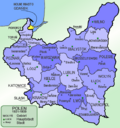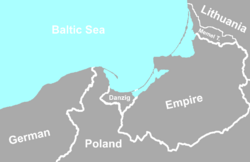Free City of Danzig
|
|||||||||||||||||||||||||||||||||||||||||||||||||||||||||||
The Free City of Danzig (German: Freie Stadt Danzig; Polish: Wolne Miasto Gdańsk) was an autonomous Baltic Sea port and city-state including over two hundred surrounding towns, established on January 10, 1920, in accordance with the terms of Part III Section XI of the Treaty of Versailles of 1919, which split it off from Germany along with other German territories. It was placed under League of Nations "protection", with special economic-related rights reserved for Poland.[1] The city was denied self-determination, despite the majority of German-speaking citizens calling for a reunion with Germany.
The status as Free City ceased to exist at the beginning of World War II in early September 1939 when German troops captured Danzig. The Free City - violating its constitution guaranteed by the League of Nations - declared Danzig part of Germany. Annexed by Germany, German anti-Semitic and anti-Polish discriminations and persecutions - including killings and deportations - hit Jewish and Polish-speaking Danzigers, against whom Danzig's Nazi Senate already discriminated before, but with Danzig's constitution, guaranteed by the League of Nations, still providing little, but some protection. Starting with the conquest by the Soviet Army in the early months of 1945, German-speaking citizens of the former Free City of Danzig were killed and expelled, and the city was put under Polish administration under its Polish name, Gdańsk, and Polish people were brought in as replacement.
Contents |
Establishment
Tradition of Independence and Autonomy
The city-state was denied to use the term of Hanseatic City as part its official name, which referred to Danzig's long-lasting membership in the Hanseatic League. Nevertheless, as part of the official name it was new for Danzig, and denied on the grounds of conforming the name of the new Danzig city-state too much to the three traditional city-states within Germany of that time, to wit the Free Hanseatic City of Bremen, the Free and Hanseatic City of Hamburg and the Free and Hanseatic City of Lübeck. In fact, to refer to the the city's membership in the Hanseatic League was understandable in the prevailing mood of many German-speaking Danzigers to remain with Germany.
But Danzig had a long tradition of city-state-like independence of its own. It was a leading player in the separatist Prussian Confederation against Violence (German: Bund vor Gewalt, or colloquially Preußischer Bund) directed against the Teutonic Monastic State of Prussia. The Confederation stipulated with the Polish king, Casimir IV Jagiellon, that the Polish Crown will be invested - in personal union - with the role of head of state of the prospectively independent separatist western parts of Teutonic Prussia, which became known as Royal Prussia (German: Preußen königlichen Anteils or Königliches Preußen). In return Casimir IV provided military support. Danzig, and the other cities, to wit Elbing and Thorn, whose main motivation to secede was to gain independence and autonomy, financed most of the warfare and managed to stipulate with Casimir IV a high level of city autonomy, unheard of in Poland or Teutonic Prussia. Therefore Danzig once in a while took pride in using the title Royal Polish City of Danzig (Polish: Królewskie Polskie Miasto Gdańsk).
When in 1569 Royal Prussia's Land Estates (German: Landtag, Polish: Sejmik) agreed to incorporate into the Polish-Lithuanian Commonwealth by way of a real union, it was again Danzig, together with Thorn (Polish: Toruń) and Elbing (Polish: Elbląg), who insisted to preserve their special status. Danzig had to go through the costly Danzig Siege in 1577, but prevailed and got all its autonomy and privileges confirmed. To make clear its position about its special status, Danzig never used the opportunity to send its represenantives to the Polish General Sejm, but always insisted to negotiate its issues by emissaries directly with the king.
Territory
The Free City of Danzig included the major city of Danzig (Gdańsk) as well as Zoppot (Sopot), Tiegenhof (Nowy Dwór Gdański), Neuteich (Nowy Staw) and some 252 villages and 63 hamlets. Covering a total area of 1,966 square kilometers (754 sq mi), the territory was roughly twice the size of the Napoleonic statelet.
Polish rights declared by Treaty of Versailles
The Free City was to be represented abroad by Poland and forced to be in a customs union with it. The German railway line that connected the Free City with newly created Poland was to be administered by Poland, as well as all rail lines in the territory of the Free City. Similarly, the Westerplatte (until then a city beach), was also given to Poland, which created a military post within the city's harbour. There was also a separate Polish post-office established besides the existing municipal one.
League of Nations High Commissioners
Unlike mandated territories, which were entrusted to member countries, Danzig like the Territory of the Saar Basin remained under the authority of the League of Nations itself, with representatives of various countries taking on the role of High Commissioner:[2]
| Name | Period | Country | |
|---|---|---|---|
| 1 | Reginald Thomas Tower | 1919-1920 | |
| 2 | Edward Lisle Strutt | 1920 | |
| 3 | Bernardo Attolico | 1920 | |
| 4 | Richard Cyril Byrne Haking | 1921-1923 | |
| 5 | Mervyn Sorley McDonnell | 1923-1925 | |
| 6 | Joost Adriaan van Hamel | 1925-1929 | |
| 7 | Manfredi di Gravina | 1929-1932 | |
| 8 | Helmer Rosting | 1932-1934 | |
| 9 | Seán Lester | 1934-1936 | |
| 10 | Carl Jakob Burckhardt | 1937-1939 |
Population

The Free City had a population of 357,000 (1919), 95% of whom were German-speakers [3], with the rest mainly speaking either Kashubian or Polish.

The Treaty of Versailles, which had severed Danzig and surrounding villages from Germany, now required that the newly formed state had its own citizenship, based on residency. German inhabitants lost their German nationality with the creation of the Free City, but were given the right within the first two years of the state's existence to re-obtain it; however, if they did so they were required to leave their property and make their residence outside of the Free State of Danzig area in the remaining part of Germany.[1]
| Nationality | Total | German | German and Polish | Polish, Kashub, Masurian | Russian, Ukrainian | Hebrew, Yiddish | Unclassified |
|---|---|---|---|---|---|---|---|
| Danzig | 335,921 | 327,827 | 1,108 | 6,788 | 99 | 22 | 77 |
| Non-Danzig | 30,809 | 20,666 | 521 | 5,239 | 2,529 | 580 | 1,274 |
| Total | 366,730 | 348,493 | 1,629 | 12,027 | 2,628 | 602 | 1,351 |
| Percent | 100.00% | 95.03% | 0.44% | 3.28% | 0.72% | 0.16% | 0.37% |
Politics

| Name | Took Office | Left Office | Party | |
|---|---|---|---|---|
| Presidents of the Danzig senate | ||||
| 1 | Heinrich Sahm | 6 December 1920 | 10 January 1931 | none |
| 2 | Ernst Ziehm | 10 January 1931 | 20 June 1933 | DNVP |
| 3 | Hermann Rauschning | 20 June 1933 | 23 November 1934 | NSDAP |
| 4 | Arthur Karl Greiser | 23 November 1934 | 23 August 1939 | NSDAP |
| State President | ||||
| 4 | Albert Förster | 23 August 1939 | 1 September 1939 | NSDAP |
It became clear almost at once that the overwhelming German majority population of the Free State resented the concessions which had been made to Poland and their dismemberment from Germany. Professor Burckhardt, the League of Nations' High Commissioner in Danzig found, by 1939, his position as absolute arbiter in the endless disputes almost untenable.
In May 1933, the Nazi Party won the local elections in the city. However, they received 57 percent of the vote, less than the two-thirds required by the League of Nations to change the Constitution of the Free City of Danzig. The government introduced anti-Semitic and anti-Catholic laws, the latter primarily being directed against the newly brought in Poles and Kashubian inhabitants. The city also served as a training point for members of the German minority within Poland that, recruited by organisations such as the Jungdeutsche Partei ("Young German Party") and the Deutsche Vereinigung ("German Union"), would form the leading cadres of Selbstschutz, an organisation involved with murder and atrocities during the German invasion of Poland in 1939[1] As throughout Germany, Jews were increasingly persecuted; the Danzig Great Synagogue was taken over and demolished by the local authorities in 1939.
Despite several years of proposals by the German governments, both before and after 1933, to renegotiate Danzig's anomalous position, Poland refused, and as late as April 1939 Professor Burckhardt was told by the Polish Commissioner-General that any attempt to alter its status would be answered with armed resistance on the part of Poland.[4]
Second World War and aftermath
The Nazi government voted for re-unification with Germany on September 2, 1939, the day after the German invasion of Poland began. Although illegal under the terms of the city's constitution, the state was nevertheless formally incorporated by Germany into the newly-formed Reichsgau of Danzig-West Prussia. Polish civilian Post Office employees had been trained and had a cache of weapons, mostly pistols, three light machine guns and some hand grenades, when they defended the Polish Post Office for 15 hours. They were executed upon their surrender, against international law. The Polish military forces in the city held out until the 7th at the fortified Westerplatte. About 10,000 members of the Polish intelligentsia were executed within the first week of the German invasion.
Around 90% of the city was reduced to ruins towards the end of the Second World War. On March 30, 1945 the city was taken by the Red Army. It is estimated that more than 90% of the pre-war population were either dead or had fled by 1945. A number of inhabitants of the city perished in the sinking of a ship assisting evacuation, the Wilhelm Gustloff. It had up to 10,000 refugees on board at the time, including about 1,000 seriously wounded soldiers and sailors.
The Allied Powers were presented with a communist fait accompli at the Potsdam conference that the former Free State was now part of Poland. (The Yalta conference was unclear on this point).
By 1950, around 285,000 citizens of the former Free City were living in Germany and 13,424 citizens of the former Free City had been "verified" and granted Polish citizenship.[5] By 1947 126,472 German-speaking Danzigers were expelled to Germany from Gdańsk, and 101,873 Poles from Central Poland and 26,629 Poles from Soviet-annexed Eastern Poland took their place.[5]
Due to this radical replacement of the native Danzigers by Polish citizens, the Free City of Danzig, wasn’t ever really discussed to be reconstituted after the Iron Curtain had come down.
See also
- Gdańsk
- Danzig Corridor
- Alfons Flisykowski
- Danzig Research Society
- History of Gdańsk
- Interwar period
- Administrations of Danzig before April 1945
- Defense of the Polish Post Office in Danzig
- Arthur Greiser (Nazi Politician)
- Albert Förster (Nazi Politician)
- Oliwa
- Westerplatte
- Free City of Danzig (Napoleonic)
References
- ↑ 1.0 1.1 Yale Law School. "The Versailles Treaty June 28, 1919 : Part III". The Avalon Project. Retrieved on 2007-05-03.
- ↑ 2.0 2.1 "Danzig subsection of Poland entry from World Statesmen.org".
- ↑ Encyclopaedia Britannica Year Book, 1938
- ↑ Woodward, E.L., Butler, Rohan, Orde, Anne, editors, Documents on British Foreign Policy 1919 - 1939, 3rd series, vol.v, HMSO,London, 1952:25
- ↑ 5.0 5.1 Bykowska, Sylwia (2005). "Gdańsk - Miasto (Szybko) Odzyskane" (in Polish). Biuletyn Instytutu Pamięci Narodowej 9-10 (56-57): 35–44. ISSN 1641-9561. http://www.ipn.gov.pl/portal/pl/24/1363/.
External links

- H.G. Wells on the Polish Corridor (WikiSource)
- Jewish community history
- History of Gdansk/Danzig
- Gdańsk history
- In 1997 Gdansk celebrated his thousand anniversary
- history & hallucination
- The power of Gdansk


